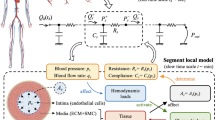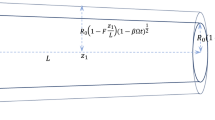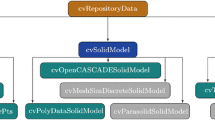Abstract
We propose an algorithmic scheme for the numerical calculation of fiber orientations in arterial walls. The basic assumption behind the procedure is that the fiber orientations are mainly governed by the principal tensile stress directions resulting in an improved load transfer within the artery as a consequence of the redistribution of stresses. This reflects the biological motivation that soft tissues continuously adapt to their mechanical environment in order to optimize their load-bearing capacities. The algorithmic scheme proposed here enhances efficiency of the general procedure given in Hariton et al. (Biomech Model Mechanobiol 6(3):163–175, 2007), which consists of repeatedly identifying a favored fiber orientation based on the principal tensile stresses under a certain loading scenario, and then re-calculating the stresses for that loading scenario with the modified favored fiber orientation. Since the method still depends on a highly accurate stress approximation of the finite element formulation, which is not straightforward to obtain in particular for incompressible and highly anisotropic materials, furthermore, a modified model is introduced. This model defines the favored fiber orientation not only in terms of the local principal stresses, but in terms of the volume averages of the principal stresses computed over individual finite elements. Thereby, the influence of imperfect stress approximations can be weakened leading to a stabilized convergence of the reorientation procedure and a more reasonable fiber orientation with less numerical noise. The performance of the proposed fiber reorientation scheme is investigated with respect to different finite element formulations and different favored fiber orientation models, Hariton et al. (Biomech Model Mechanobiol 6(3):163–175, 2007) and Cyron and Humphrey (Math Mech Solids 1–17, 2014). In addition, it is applied to calculate the fiber orientation in a patient-specific arterial geometry.















Similar content being viewed by others
References
Ball JM (1977) Convexity conditions and existence theorems in non-linear elasticity. Arch Ration Mech Anal 63:337–403
Balzani D, Böse D, Brands D, Erbel R, Klawonn A, Rheinbach O, Schröder J (2012) Parallel simulation of patient-specific atherosclerotic arteries for the enhancement of intravascular ultrasound diagnostics. Eng Comput 29(8):888–906
Balzani D, Deparis S, Fausten S, Forti D, Heinlein A, Klawonn A, Quarteroni A, Rheinbach O, Schröder J (2015) Numerical modeling of fluid-structure interaction in arteries with anisotropic polyconvex hyperelastic and anisotropic viscoelastic material models at finite strains. Int J Numer Methods Biomed Eng. ISSN 2040-7947 doi:10.1002/cnm.2756
Balzani D, Neff P, Schröder J, Holzapfel GA (2006) A polyconvex framework for soft biological tissues. adjustment to experimental data. Int J Solids Struct 43(20):6052–6070
Boehler JP (1987) Introduction to the invariant formulation of anisotropic constitutive equations. In: Boehler JP (eds) Applications of tensor functions in solid mechanics, number 292 in Courses and Lectures of CISM, Springer, Berlin, pp. 13–30
Brands D, Klawonn A, Rheinbach O, Schröder J (2008) Modelling and convergence in arterial wall simulations using a parallel FETI solution strategy. Comput Methods Biomech Biomed Eng 11(5):569–583
Creane A, Maher E, Sultan S, Hynes N, Kelly DJ, Lally C (2011) Prediction of fibre architecture and adaptation in diseased carotid bifurcations. Biomech Model Mechanobiol 10:831–843
Creane A, Maher E, Sultan S, Hynes N, Kelly DJ, Lally C (2012) A remodelling metric for angular fibre distributions and its application to diseased carotid bifurcations. Biomech Model Mechanobiol 11:869–882
Cyron CJ, Humphrey JD (2014) Preferred fiber orientations in healthy arteries and veins understood from netting analysis. Math Mech Solids, 20(6):680–696
Driessen N, Peters G, Huyghe J, Bouten C, Baaijens F (2008) Remodelling of continuously distributed collagen fibres in soft connective tissues. J Biomech 36(8):1151–1158
Driessen N, Wilson W, Bouten C, Baaijens F (2004) A computational model for collagen fibre remodelling in the arterial wall. J Theor Biol 226(1):53–64
Grillo A, Wittum G, Tomic S, Federico A (2015) Remodelling in statistically oriented fibre-reinforced materials and biological tissues. Math Mech Solids 20:1107–1129
Hariton I, deBotton G, Gasser TC, Holzapfel GA (2007a) Stress-driven collagen fiber remodeling in arterial walls. Biomech Model Mechanobiol 6(3):163–175
Hariton I, de Botton G, Gasser TC, Holzapfel GA (2007b) Stress-modulated collagen fiber remodeling in a human carotid bifurcation. J Theor Biol 248(3):460–470
Hartmann S, Neff P (2003) Polyconvexity of generalized polynomial-type hyperelastic strain energy functions for near-incompressibility. Int J Solids Struct 40:2767–2791
Himpel G, Menzel A, Kuhl E, Steinmann P (2008) Time-dependent fibre reorientation of transversely isotropic continua-finite element formulation and consistent linearization. Int J Numer Methods Eng 73(10):1413–1433
Holzapfel G (2006) Determination of material models for arterial walls from uniaxial extension tests and histological structure. J Theor Biol 238(2):290–302
Holzapfel GA, Gasser TC, Ogden RW (2000) A new constitutive framework for arterial wall mechanics and a comparative study of material models. J Elast Phys Sci Solids 61(1–3):1–48
Kuhl E, Holzapfel GA (2007) A continuum model for remodeling in living structures. J Mater Sci 42(21):8811–8823
Menzel A, Waffenschmidt T (2009) A microsphere-based remodelling formulation for anisotropic biological tissues. Philos Trans R Soc A 367:3499–3523
O’Connell MK, Murthy S, Phan S, Xu C, Buchanan J, Spilker R, Dalman RL, Zarins CK, Denk W, Taylor CA (2008) The three-dimensional micro- and nanostructure of the aortic medial lamellar unit measured using 3d confocal and electron microscopy imaging. Matrix Biol 27:171–181
Qi N, Ogden RW, Hill NA, Holzapfel GA, Han H, Luo X (2015) Investigation of the optimal collagen fibre orientation in human iliac arteries. J Mech Behav Biomed Mater. doi:10.1016/j.jmbbm.2015.06.11
Sansour C (2008) On the physical assumptions underlying the volumetric-isochoric split and the case of anisotropy. Eur J Mech A Solids 27:28–39
Schriefl AJ, Wolinski H, Regitnig P, Kohlwein SD, Holzapfel GA (2012) An automated approach for three-dimensional quantification of fibrillar structures in optically cleared soft biological tissues. J R Soc Interface, 10(80):20120760. doi:10.1098/rsif.2012.0760. URL http://rsif.royalsocietypublishing.org/content/10/80/20120760
Schröder J (2010) Anisotropic polyconvex energies. In: Schröder J, Neff P (eds) Poly-, quasi- and rank-one convexity in applied mechanics. Springer, Berlin, pp 53–105
Schröder J, Brinkhues S (2014) A novel scheme for the approximation of residual stresses in arterial walls. Arch Appl Mech 84:881–898
Schröder J, Neff P (2003) Invariant formulation of hyperelastic transverse isotropy based on polyconvex free energy functions. Int J Solids Struct 40:401–445
Schröder J, Neff P, Balzani D (2005) A variational approach for materially stable anisotropic hyperelasticity. Int J Solids Struct 42(15):4352–4371
Schröder J, von Hoegen M (2016) An engineering tool to estimate eigenstresses in three-dimensional patient-specific arteries. Comput Methods Appl Mech Eng 306:364–381
Simo JC, Taylor RL, Pister KS (1985) Variational and projection methods for the volume constraint in finite deformation elasto-plasticity. Comput Methods Appl Mech Eng 51:177–208
Takizawa K, Torii R, Takagi H, Tezduyar TE, Xu XY (2014) Coronary arterial dynamics computation with medical-image-based time-dependent anatomical models and element-based zero-stress state estimates. Comput Mech 54:1047–1053
Taylor RL (2014) FEAP: finite element analysis program. URL http://www.ce.berkeley/feap
Waffenschmidt T, Menzel A (2014) Extremal states of energy of a double-layered thick-walled tube: application to residually stressed arteries. J Mech Behav Biomed Mater 29:635–654. doi:10.1016/j.jmbbm.2013.05.023
Acknowledgments
Financial support of the German Science Foundation (DFG) under the project no. SCHR570/15-1 and BA2823/9-1 is highly acknowledged. The author D. Balzani additionally thanks the DFG for funding in the context of the Institutional Strategy “The Synergetic University” at TU Dresden, as part of the Excellence Initiative. Furthermore the cooperation with our co-worker Markus von Hoegen, especially in the context of residual stresses in arterial walls, is highly acknowledged.
Author information
Authors and Affiliations
Corresponding author
Rights and permissions
About this article
Cite this article
Fausten, S., Balzani, D. & Schröder, J. An algorithmic scheme for the automated calculation of fiber orientations in arterial walls. Comput Mech 58, 861–878 (2016). https://doi.org/10.1007/s00466-016-1321-z
Received:
Accepted:
Published:
Issue Date:
DOI: https://doi.org/10.1007/s00466-016-1321-z




